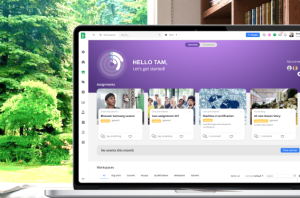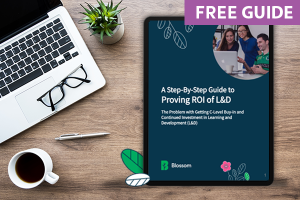Learn about skills inference in L&D and discover how to leverage this approach to enhance your organisation’s L&D initiatives, to align your workforce with business goals.
Understanding how learning and development (L&D) programs benefit your people is critical to any organisation. Without solid data, you may struggle to pinpoint your employees’ specific needs and areas for improvement.
Skills inference uses semantic data to explore the nuances of employee skills and expertise. By harnessing skills inference, you can navigate beyond surface-level information. This knowledge will help you tailor L&D initiatives and develop a successful L&D strategy aligned with corporate objectives.
Get a comprehensive understanding of your workforce’s capabilities. Discover how to leverage skills inference to enhance your organisation’s L&D initiatives.
What is skills inference?
Skills inference involves analyzing semantic data to extract meaningful information about employees’ skills and expertise. It allows you to identify precisely which skills and expertise employees have or need.
With this detailed understanding, you can design L&D programs strategically to fill specific gaps, have a meaningful impact, play a vital role in individual growth and contribute significantly to success.
Let’s put that into practice and say a software company sees its employees need advanced coding skills as the tech industry evolves. As a result, the L&D team provides a coding boot camp for interested employees to fill this skill gap. This helps employees who want to improve their skills and the company stay competitive. Employees gain valuable coding expertise and grow professionally, and the company enhances its workforce to meet current industry needs.
Although skills inference can help you track employee progress and get a complete overview of compliance and performance, it typically struggles to identify different levels of employee skills. If we take communication skills as an example, skills inference may not accurately gauge the nuanced levels of proficiency or effectiveness in communication.
Blossom can provide semantic data with customisable analytics and reporting tools to make workforce learning and performance data more visual, meaningful, and actionable.

How skills inference can be applied in L&D
1. Offer adaptive learning platforms
Skills inference facilitates the creation of personalised learning paths that cater to individual employees’ specific needs and aspirations. Organisations can design tailored training programs that go beyond generic content by analyzing employees’ current skills and career goals.
As employees progress through courses, the Blossom platform adapts by adjusting the difficulty and content based on their demonstrated skills. So if an employee quickly masters certain concepts, the platform can move on to more advanced topics, ensuring a personalised and efficient learning experience.
- “Blossom has saved Guberman Group significant time, especially for our managers and the coaches/buddies for new employees. It has streamlined the way we work through having accessible content that is relevant to the employee skill level, seniority, and qualification levels.” –Bar Ostrovsky, Internal Auditor at Guberman Group
Conversely, Blossom technology can provide additional support and resources if an employee faces challenges. This adaptability ensures that each employee receives tailored content suited to their unique learning pace and abilities.
When we look at a healthcare setting, skills inference can show that Nurse A is skilled in clinical work and wants to become a nursing manager. Nurse A’s personalised learning path includes healthcare leadership, team management, and administration modules.
At the same time, Nurse B, who aims to specialise in a specific nursing area, gets a personalised path with advanced clinical practices, specialised certifications, and the latest updates in that field. Skills inference ensures that nurses’ training matches their career goals, making the programs more relevant and motivating.

Take it from Shai Ashkenazi, Head of Training and Development at RAMBAM Health Care Campus, who says, “Blossom LMS really helped us meet the training needs of our team. Its sophisticated functions really help us deliver personalised training around our hospital staff’s busy schedules and 24/7 shift patterns. Now our 90% of our 6000 employees are accessing training, from anywhere at any time on any device.”
2. Analyse employee performance
Some 95% of employers identify driving organisational performance as a critical objective for performance management, yet only 45% feel that their current program is achieving this goal.
Identifying high-potential employees, planning succession, and addressing skills gaps become more difficult without a semantic understanding of employee skills. This can hinder talent development and retention efforts.
Skills inference analyzes employee performance and training data, helping you create a focused training program to fill skill gaps. This ensures employees acquire the necessary expertise to succeed in their roles.
3. Monitor project outcomes
Ineffective workforce planning may lead to delays, such as missed deadlines, increased project costs, and potential setbacks in achieving project objectives.
Skills inference offers insight into employees’ skill sets, improving workforce planning. This information helps align your workforce with business goals, enabling better resource allocation and task assignment.
For example, in a construction company, poor planning caused delays in getting the necessary permits for a big project. This increased labour costs because workers had nothing to do while waiting.
Skills inference can be used to understand the workforce’s abilities and improve collaboration and planning. The company can then use these insights to assign tasks more effectively, avoiding unnecessary delays and reducing costs linked to idle time.
4. Identify employee strengths and weaknesses
Without analyzing solid data, it’s challenging to understand employees’ skills, leading to underutilisation of their talents. Neglecting data for skill trends may prevent you from missing emerging needs, especially in fast-changing industries like technology and healthcare.
As skills inference identifies employee strengths and areas for development, it helps in succession planning by evaluating current skills and growth potential.
Get a deep understanding of employee strengths and areas for development. Pinpoint areas that need upskilling or reskilling, such as improving time management skills or other essential competencies.
A Learning Experience Platform (LXP) can track employee progress, highlighting individual, team, and whole organisational strengths and weaknesses. You and your team can use this information to create personalised learning paths, supporting continuous development and aligning L&D initiatives with broader corporate objectives.
5. Increase employee engagement
Employees often appreciate when their skills and expertise are recognised and utilised. Solid data analysis, like skills inference, allows you to recognise employee effort and assign tasks that align with strengths, increasing job satisfaction and boosting employee engagement.
Leverage skills inference to improve employee engagement and offer a more personalised, meaningful work experience with:
- Improved communication. Tailoring communication based on individual preferences and roles enhances clarity and relevance, creating a stronger connection between employees and the organisation.
- Personalised recognition and rewards. Skills inference can help you customise employee recognition and rewards. By understanding individual achievements, skills, and contributions, you can offer tailored recognition and rewards, reinforcing a positive and engaged work environment.
- Customised career paths. Map employees’ skills, experiences, and career aspirations. Use this information to offer customised career paths and opportunities that align with individual goals.
- Improved employee feedback. Provide more targeted and constructive feedback, addressing individual needs and areas for improvement. Use semantic data to reinforce a growth-oriented mindset amongst your employees and increase engagement.
- Increased autonomy and empowerment. Delegating tasks that align with employees’ strengths provides a sense of independence and empowerment, contributing to engagement.
6. Make better decisions
Strategic decision-making depends on understanding the workforce’s capabilities. Without skills inference, decisions regarding hiring, training, and project assignments may be misinformed.
Semantic data offers a better understanding of prevalent skills in the workforce, leading to more efficient resource allocation. This allows directing L&D budgets and efforts toward areas that directly impact your organisation’s goals, avoiding investment in training programs that do not align with priorities.
Consider a marketing company without skills inference. They might struggle to identify the specific areas of expertise within their team. With skills inference, the agency can recognise that certain team members excel in social media marketing while others have strong skills in content creation. This knowledge allows the agency to make informed decisions, such as assigning the right team members to projects that align with their strengths. This targeted approach ensures optimal resource utilisation.
Leverage skills inference with Blossom
L&D teams are constantly doing more with fewer resources. Managing budgets, prioritising resources, and balancing workforce capabilities need innovative solutions that maximise impact and efficiency.
Skills inference can help optimise these efforts by providing insights into workforce development, allowing you to tailor training initiatives more precisely and allocate resources efficiently.Use skills inference with Blossom to enhance the effectiveness of your L&D initiatives. Schedule a demo to learn more.








